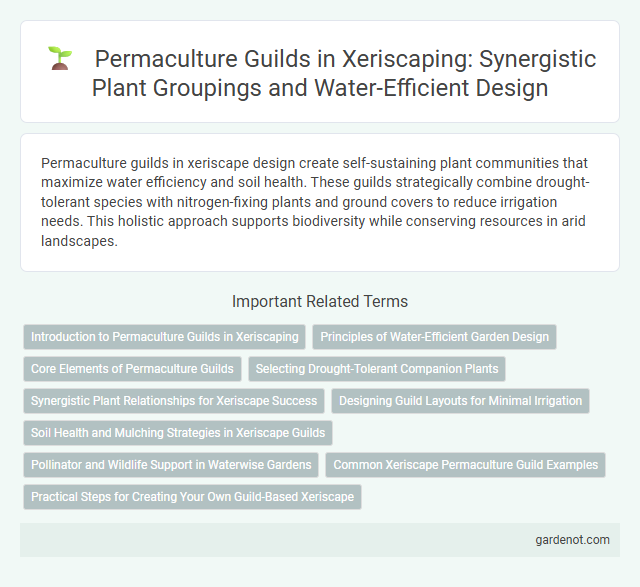Permaculture guilds in xeriscape design create self-sustaining plant communities that maximize water efficiency and soil health. These guilds strategically combine drought-tolerant species with nitrogen-fixing plants and ground covers to reduce irrigation needs. This holistic approach supports biodiversity while conserving resources in arid landscapes.
Introduction to Permaculture Guilds in Xeriscaping
Permaculture guilds in xeriscaping create synergistic plant communities that enhance water conservation and soil health by combining drought-tolerant species with complementary functions. These guilds optimize resource use, improve biodiversity, and reduce maintenance through natural interactions like nitrogen fixing, pest control, and nutrient cycling. Implementing guilds tailored for arid environments supports sustainable landscaping that thrives with minimal irrigation.
Principles of Water-Efficient Garden Design
Permaculture guilds enhance xeriscape gardens by integrating plant species that support water conservation through efficient root structures and natural mulching, which reduces evaporation. Water-efficient garden design principles emphasize soil improvement for maximum water retention, strategic plant placement to capture runoff, and the use of drought-tolerant native plants that thrive with minimal irrigation. Key techniques include contour planting, rainwater harvesting systems, and the creation of microclimates to optimize water use and sustain healthy ecosystems.
Core Elements of Permaculture Guilds
Permaculture guilds center around core elements such as diverse plant species that fulfill complementary roles like nitrogen fixation, pest control, and nutrient accumulation to create a self-sustaining ecosystem. Key components include nitrogen-fixing plants, dynamic accumulators, pollinator attractors, and ground covers that reduce soil erosion and retain moisture. Integrating these elements into a xeriscape maximizes water efficiency, enhances soil health, and promotes biodiversity in arid environments.
Selecting Drought-Tolerant Companion Plants
Permaculture guilds designed for xeriscaping prioritize selecting drought-tolerant companion plants that improve soil health and water retention. Key species such as native succulents, deep-rooted herbs, and nitrogen-fixing legumes create resilient plant communities that optimize limited water availability. Incorporating drought-resistant plants like Agave, Lavender, and Yarrow enhances ecosystem stability by reducing evapotranspiration and supporting beneficial insect habitats.
Synergistic Plant Relationships for Xeriscape Success
Permaculture guilds enhance xeriscape success by fostering synergistic plant relationships that optimize water conservation and soil health. Key plant combinations include drought-tolerant species like native succulents paired with nitrogen-fixing legumes and deep-rooted perennials to improve nutrient cycling and moisture retention. These interdependent plant communities reduce irrigation needs, support biodiversity, and create resilient, sustainable landscapes tailored for arid environments.
Designing Guild Layouts for Minimal Irrigation
Permaculture guilds designed for xeriscape landscapes optimize plant associations to reduce water usage by combining drought-tolerant species with complimentary functions such as nitrogen-fixing, deep-rooting, and ground cover plants. Strategic placement of mulch and contouring stimulates maximal moisture retention and soil health in guild layouts, minimizing irrigation needs while promoting ecosystem resilience. Integrating native xerophytes with fruit trees and beneficial insect attractors creates self-sustaining guilds that thrive on rainfall and stored moisture, drastically lowering water requirements.
Soil Health and Mulching Strategies in Xeriscape Guilds
Permaculture guilds in xeriscaping enhance soil health by incorporating diverse plant species that fix nitrogen, improve organic matter, and support beneficial microbes, fostering a resilient ecosystem. Effective mulching strategies, such as using organic materials like wood chips and straw, conserve soil moisture, suppress weeds, and regulate soil temperature in arid environments. These practices optimize water retention and nutrient cycling, crucial for sustainable xeriscape guild productivity and long-term soil vitality.
Pollinator and Wildlife Support in Waterwise Gardens
Permaculture guilds in xeriscape gardens enhance waterwise landscaping by integrating diverse plant species that support pollinators and wildlife. Native flowering plants, drought-tolerant shrubs, and habitat features like bee hotels create essential resources for bees, butterflies, and birds while conserving water. This biodiversity promotes ecosystem resilience, improves soil health, and sustains pollination services critical for garden productivity and ecological balance.
Common Xeriscape Permaculture Guild Examples
Common xeriscape permaculture guild examples include drought-tolerant plants like lavender, sage, and yarrow that enhance soil health and water retention. These guilds combine deep-rooted perennials with nitrogen-fixing legumes and beneficial insect-attracting species to create self-sustaining ecosystems. Incorporating mulching plants like comfrey and groundcovers such as sedum helps reduce evaporation and improves overall garden resilience.
Practical Steps for Creating Your Own Guild-Based Xeriscape
Designing a xeriscape with permaculture guild principles involves selecting drought-tolerant plants that support each other's growth while conserving water. Incorporate native species, nitrogen-fixers, and deep-rooted plants to create a resilient, self-sustaining ecosystem that reduces irrigation needs. Position plants strategically for microclimate benefits and use mulch to retain soil moisture and prevent erosion.
Permaculture guild Infographic

 gardenot.com
gardenot.com